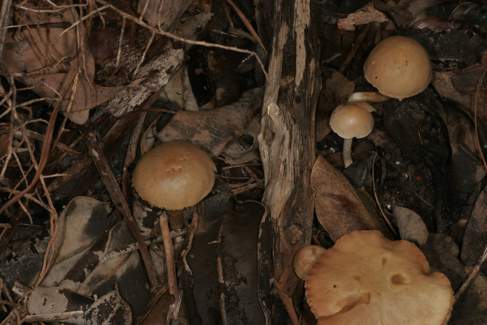 Hebeloma youngii (Photo: M.D. Barrett)
Hebeloma youngii (Photo: M.D. Barrett)Taxonomy
Full name: Hebeloma youngii B.J. Rees, Mycologia 105 (4): 1053 (2013)Genus: Hebeloma
Section: Porphyrospora
Types: AUSTRALIA: Queensland: Near Moomin, Atherton to Herberton Road (approx. 17.3642°S, 145.3967°E, alt. approx. 920 m a.s.l.) on cadaveric soil in subtropical woodland under Eucalyptus crebra, 19 Feb. 2001, P.I. Forster, R. Booth, A.M. Young (PIF26822), det: B.J. Rees (Holotype. herbarium acc. no. BRI AQ669300, HJB1000343).
- arrow_drop_downarrow_drop_upEtymology
- arrow_drop_downarrow_drop_upDiagnosisPileus 20–45 mm diam, circular, conical, becoming very broadly conical to umbonate, or nearly plane, with an even down-turned margin; pinkish brown (6C5), with an overall whitish bloom especially at the margin, initially faintly viscid but later dry and smooth. Lamellae adnate, moderately close, pinkish (6B3–6D4) with an even, concolorous margin. Stipe 30–60 x 3–6 mm, hollow to partially stuffed, exterior smooth to fibrillose, dry; light brown (4A2–4B3) or brownish (4A3). Dried spore print at stipe apex, dark tan-brown; no visible cortina recorded. Odor and flavor not recorded. Basidiospores [30/3/1] (7.8–)8.8–10.1 x 5.7–6.6 μm, Q = 1.56, pale yellow-brown, strongly dextrinoid, becoming yellowish brown to orange-brown or brick in Melzer’s reagent (D3), ovoid, verrucose with an inequilateral profile, weakly to distinctly ornamented (O2–3), perispore well developed but absent from apex, not loosening (P0). Basidia 30–35 x 8–9 μm, clavate, slightly swollen near base, sterigmata 3–6 μm long. Cheilocystidia versiform, 45–80 x 9–20 μm, awl-shaped with long, tapering lageniform to slightly capitate apices, occasionally septate, hyaline. Pleurocystidia present, but shorter, 30–40 x 10–15 μm, with a short, mainly rostrate apex. Caulocystidia present only at the stipe apex as short, narrow hyphae with small capitate endings. Pileipellis composed of two layers, an outer thin network of loosely interwoven, hyaline, lightly gelatinized, encrusted cells, 1–2 μm wide with small capitate endings, above a more deeply pigmented layer of much larger allantoid to isodiametric cells up to 10 μm wide, unclamped.
References
Description
- arrow_drop_downarrow_drop_upThresholds
Description of Hebeloma youngii based on 3 collections
- arrow_drop_downarrow_drop_upMacroscopic descriptionPileus: (10) 27–32 (45) mm diameter; shape often papillate, umbonate or broadly umbonate; characters pubescent or remains of universal veil; margin characters Not recorded; viscosity tacky when moist; colour variation two color; colour at centre dark brick.
Lamellae: attachment adnate; maximum depth not recorded; number of complete lamellae 48–56; presence of tears absent; white fimbriate edge often absent or present.
Cortina presence: variable.
Stipe: (30) 45–56 (70) x (2) 3–4 (6) {median} x (2) 3–5 (6) {basal} mm; stipe Q 10.0–18.0; base shape clavate or cylindrical; floccosity fibrillose, often velute; rooting no; thick rhizoids at base absent;
Context: Texture firm; stipe interior hollow; stipe flesh discolouring no; slenderness measure 14.2–51.4; smell Not recorded; taste Not recorded.
Spore deposit colour: Not recorded.
Exsiccata characters: Not recorded.
- arrow_drop_downarrow_drop_upMicroscopic descriptionSpores: shape amygdaloid; colour in microscope brown; guttules often yes or weak. papilla no; Spore Code: O2 O3; P2 P3; D3.
Basidia: 24–32 x 6–7 μm; ave. Q 3.7–4.5; spore arrangement 4 spored;
Cheilocystidia: main shape lanceolate or ventricose, often lageniform; special features observed often rostrate; cheilocystidia ratios: A/M = 0.81–0.94; A/B = 0.36–0.41; B/M = 2.31–2.36.
Pleurocystidia: seen.
Ixocutis: epicutis thickness (measured from exsiccata) up to 30 μm; ixocutis hyphae width up to 4 μm; ixocutis hyphae encrustation no; shape of trama elements beneath subcutis cylindrical up to 11 μm wide.
Caulocystidia: Similar to cheilocystidia but larger, up to 50 μm.
- arrow_drop_downarrow_drop_upSpore measurements
- arrow_drop_downarrow_drop_upCheilocystidia measurements
- arrow_drop_downarrow_drop_upHabitat and distributionHebeloma youngii's preferred habitat appears to be woodland clearing or subtropical woodland with cadaveric (cow) soil or cadaveric soil. Where only one possible associate was recorded, that associate has always been Eucalyptus (family Myrtaceae). We have additional records where Allocasuarina was recorded as a possible associate, but for these collections a number of possible associates were mentioned. Overall the most commonly recorded families are Myrtaceae (100.0%) and Casuarinaceae (50.0%) No growth habit has been recorded.
According to our current collections, the species is found only in Australasia. On the continent, collections have been found only in the Queensland tropical rain forests WWF ecoregion The World Wildlife Fund (WWF) have divided the world into 867 terrestrial ecoregions. The ecoregion here is estimated by mapping from the GPS coordinates of the collection using data made available by Dinerstein et al (2017). Use this webtool to explore the ecoregions visually or see a full list of current ecoregions on Wikipedia. (tropical & subtropical moist broadleaf forests biome). From collector information, it appears collections have been found in the 1.4 Forest – Temperate (50.0%) and 1.5 Forest – Subtropical/tropical dry (50.0%) IUCN habitats We map from the collector's description of the habitat to the International Union for Conservation of Nature (IUCN)'s definition using a standardised set of rules. Please see this page for a full list of IUCN habitats.. Within Australasia all our records are from Australia (Queensland and Northern Territories).
Geographic distribution
Phenology
- arrow_drop_downarrow_drop_upAdditional cited collections